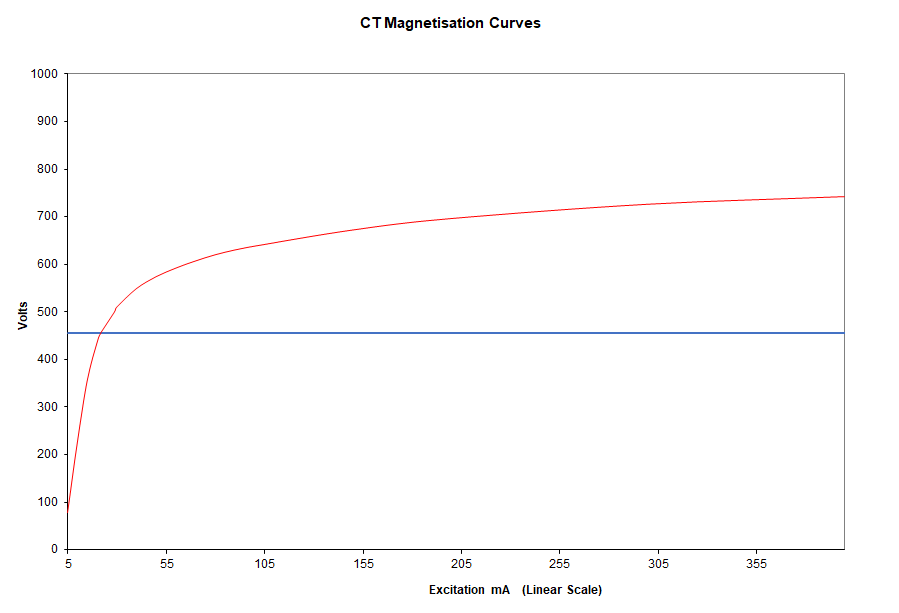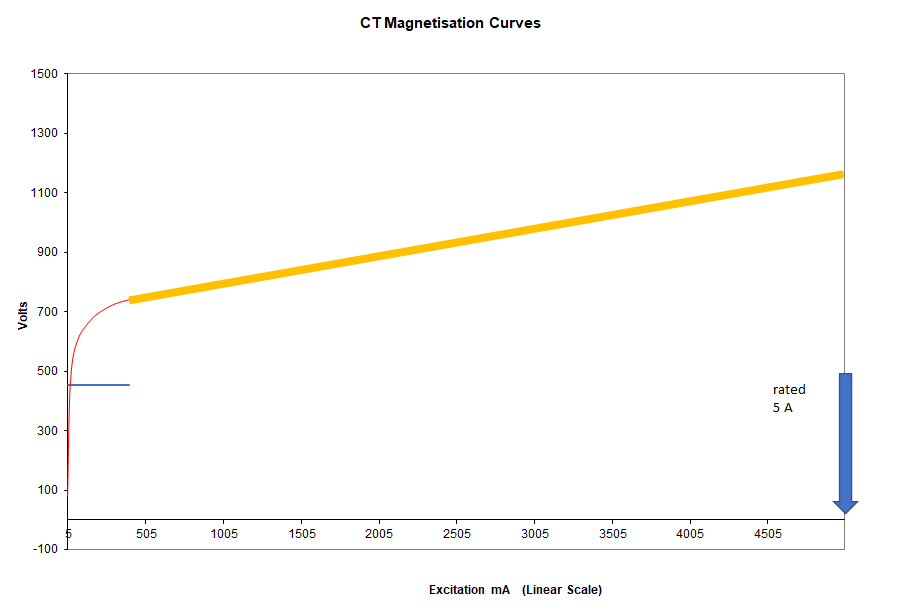Current Transformer Shorting
| Rod Hughes Consulting General Web Site | Applications Home | Innovations and Solutions Home | A bit about Rod Hughes |
|
|---|
Note - if the navigation pane on the left of this window is not visible, click the 2-pane icon on the top bar
I often see questions about why unused cores must be shorted.
Earthing of CT circuits is also essential, as in any electrical system in the substation, but that is a totally different requirement for totally different reasons.
I prefer to avoid referring to fluxes and things we can't easily see or measure.
I will just talk about amps and volts ... excitation amps and kneepoint volts, both of which we can directly measure.
An ideal (zero loss) CT has to keep ampere.turns balance equal on primary and secondary.
Iprimary x Tprimary must equal Isecondary x Tsecondary
CTs can be modelled as an ideal CT with a loss factor described as the excitation current.
If the CT has open circuit secondary, obviously the the secondary output current is zero.
However the "internal ideal ct" is producing current to maintain Ampere.Turns balance.
If it is producing current, but the overall output is zero, where is the current going?
Kirchhoff's Law says that the sum of the currents at a node must equal zero.
Hence the only path for all that current produced by the ideal CT secondary to flow is through the excitation path.
Lets consider the mag curve of a real 10000/5 CT as plotted below on a linear scale. It has a calculated kneepoint of 455V and 21.8 mA excitation current at kneepoint.
However what if the primary current is 100% rated value.
That should produce 100% rated current in the secondary, i.e. 5 A, all of which can only flow through the excitation path if the CT is open circuit.
That 100% of rated current is 230 x the excitation value measured at kneepoint.
Hence we know we are pushing the CT secondary voltage w.a.y. above kneepoint.
The excitation or magnetising curve would mean that we have a huge increase in secondary voltage.
A simple extrapolation is shown below to rated secondary current suggesting something more than 1100 V being developed by the CT- that is bad enough as it may start to impinge on, or exceed insulation ratings of the wiring!
But what if the primary current is at maximum fault current of ,say, 20 x rated = 100 A.
The expected CT current would therefore be 4587 x the kneepoint excitation current all flowing through the excitation path.
That is pushing the volts on the mag curve SUPER HIGH, and is highly likely to exceed rated insulation voltage causing a flash over at the CT terminals or in the wiring or connected equipment, and/or danger to personnel touching the wires.
So ... Golden Rule
NEVER leave a CT secondary open circuit.
It must be connected to a burden or have a short circuit applied.
Exception to the Rule: Tapped CTs or CTs with multiple secondary windings
There is an important variation to the Golden Rule for Tapped CTs or CTs with multiple secondary windings on the same core
Burden must only be connected to one pair of terminals.
The other terminals must be left disconnected.
As long as Ampere.Turns balance is achieved between the primary of the core and the secondary of the core, the CT can work "normally".
In the case of the One core, Two individual secondary windings (a typical arrangement is an independent "test" winding), consider what would happen if the test winding was short circuited.
Since the test winding connected burden is virtually zero Ohms, the required voltage on the mag curve is minimal, and hence all the CT output current will appear through that shorted winding. There will be no current flowing through the connected burden of the other CT.
Similarly if you connect two equal burdens to each winding, you will get half the current through each secondary as
Iprimary x Tprimary = ( Isecondary1 x Tsecondary1 ) + ( Isecondary2 x Tsecondary2 )
In the case of the multiple tapped winding, the same problem would occur if you shorted the extra terminal(s) .. the intended terminals would have zero current or share the output according to the connected burdens of each terminal pair.
Copy this permanent link to this page: https://rhconsult.tiny.us/ytuscxay
- Protection Systems Engineering
- IEC 61850 Engineering
I provide a range of courses for company-specific in-house training and occasional public invitation courses. Contact me for details.
Contact Me
A phone call is nearly always welcome depending on the time of night wherever I am in the world.
Based in Adelaide UTC +9:30 hours e.g.
| April-September | Noon UK = 2030 Adelaide |
| October-March: | Noon UK = 2230 Adelaide |
Mobile + 61 419 845 253
Extra Notes:
No Waiver, No Licence:
Rod Hughes Consulting Pty Ltd accepts no direct nor consequential liability in any manner whatsoever to any party whosoever who may rely on or reference the information contained in these pages. Information contained in these pages is provided as general reference only without any specific relevance to any particular intended or actual reference to or use of this information. Any person or organisation making reference to or use of this information is at their sole responsibility under their own skill and judgement.
This page is protected by Copyright ©
Beyond referring to the web link of the material and whilst the information herein is accessible "via the web", Rod Hughes Consulting Pty Ltd grants no waiver of Copyright nor grants any licence to any extent to any party in relation to this information for use, copy, storing or redistribution of this material in any form in whole or in part without written consent of Rod Hughes Consulting Pty Ltd.





